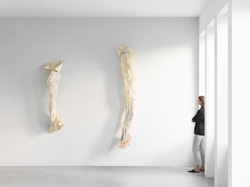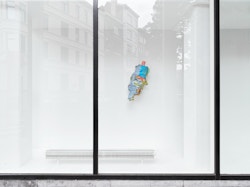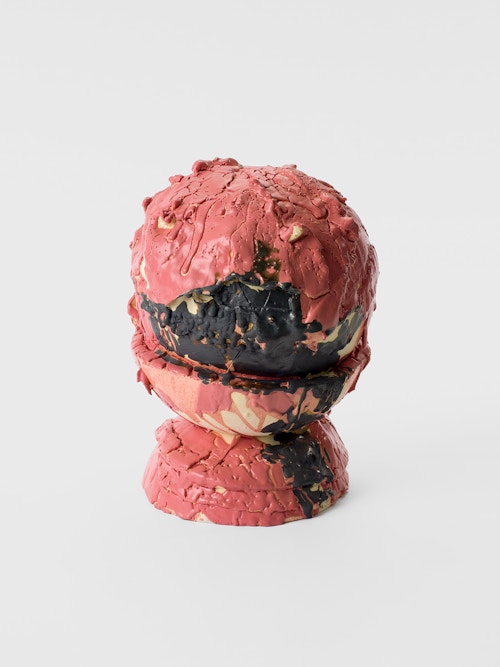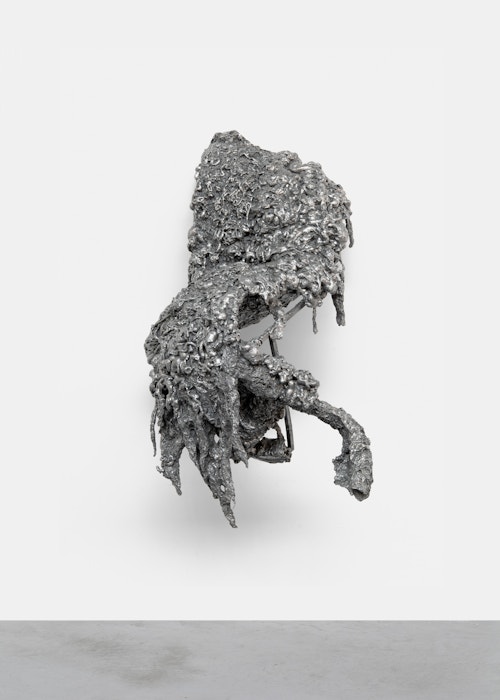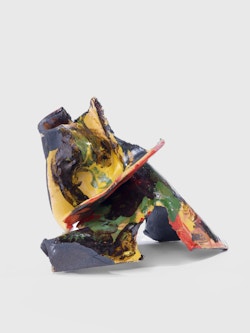
Lynda Benglis WHAT IF?
WHAT IF? brings together recent work by Lynda Benglis in a wide range of media. Ceramics enter into a dialogue with cast polyurethane sculptures and a new, never previously exhibited work in aluminium, Relic (2014-2023). The selection showcases Benglis’s versatility across different techniques and materials, while also highlighting the dynamic interaction between apparent contradictions, such as organic and synthetic, fluidity and solidification, permanence and transience. The works further emphasise her abiding interest in motion, metamorphosis and the physical act of creation.
Lynda Benglis’s ceramics are the ultimate embodiment of physicality. They are also the works in which the artist’s hand is most evident. She embraces the primal qualities of clay, its tactile immediacy and organic mutability. Benglis eschews conventional tools and takes a manual approach to working the material. She twists, pokes, pulls, folds and pushes the clay into shape using her bare hands. Benglis explains: “The process includes me holding the material, which is important. When I do ceramics, I feel a need to kind of wrestle with the material and be integrated with the form and surface. I can only tell you that the thinking in it is so fast. It’s a dance. I feel the clay; I am the clay, so to speak. I feel this in all my work, that I am the material and what I am doing is embracing it and allowing it to take form.”
Inspired by natural shapes, such as geological structures, human anatomy and landscapes, the ceramics can also be read as ‘frozen gestures.’ Specifically used in connection with Benglis’s oeuvre, the term refers to her sculptural works that capture the fluidity and dynamism of a motion or action in a permanent form. Their earthy textures evoke the timeless quality of the natural world, while the vibrant colours, glazes and slips, ranging from matte to glossy, draw inspiration from abstract painterly traditions. Meanwhile, Benglis’s titles reference both her birthplace, Louisiana, and her studio in New Mexico; Choctaw and Moctobi are the names of two Native American tribes from the Mississippi region; Iberville and Bienville are parishes in Louisiana that are named after early French governors of the region; while Tewa pays homage to the linguistic family of the Pueblo Native Americans settled along the Rio Grande.

A contrasting body of work brings synthetic materiality to the fore. Benglis is renowned for her cutting-edge use of industrial substances, achieving fame in the 1960s with her poured latex sculptures. The exhibition highlights her recent explorations with spray foam and the many directions in which she has taken this medium. To craft these pieces, Benglis initially applies the foam to metal armatures, often fabricated from chicken wire. Similar to sculpting with clay, motion and expression play a vital role. Spraying is almost like drawing in three dimensions. After drying, these shapes serve as forms for casting in various media, such as polyurethane or aluminium. All of these works investigate the concept of metamorphosis. In the cast polyurethane pieces, for example, liquid polyurethane hardens into ethereal sculptures with alluring and glossy surfaces.
Benglis’s Cloud Shadow sculptures (2007) are crafted from transparent, glassy polyurethane, which creates an entirely different visual effect. These sculptures draw inspiration from the transient and ever-evolving shapes of clouds. As art critic Brenda Richardson notes: “These are forms that shift and shimmer in light and space, very much like the ghosts, shadows, clouds, and other shape-shifters, their titles evoke.” Benglis’s new sculpture Relic (2014-2023) was also cast from a foam sculpture, only into aluminium instead of polyurethane. The shift is now from an artificial, airy and light-absorbing substance to a substantial, yet mirror-like, natural one. Organic, oozing, semi-molten shapes, whose surfaces seem alive, contrast starkly with the rigidity of the metal. The crux of this transformation is the transition from ephemerality to endurance.

Lynda Benglis (b. 1941, Lake Charles, LA, USA) lives and works in New York, Sante Fe and Greece. In 2026, Benglis will be the subject of an exhibition at the Barbican in London in dialogue with the work of Giacometti. Recent solo exhibitions include Fuentes, Jardín Banca March, Madrid (2024); Recent Sculptures, Turner Contemporary, Margate, UK (2024); Lynda Benglis, Nasher Sculpture Center, Dallas (2022); Lynda Benglis, National Gallery of Art, Washington, D.C. (2021); Works in Video, Gene Siskel Film Center Virtual Cinema, Chicago (2021); Lynda Benglis: In the Realm of the Senses, curated by David Anfam, Museum of Cycladic Art, Athens (2019); Elephant Necklace, Ogden Museum of Southern Art, New Orleans (2019) and Bird’s Nest, The Harwood Museum of Art, University of New Mexico, Taos (2019).
